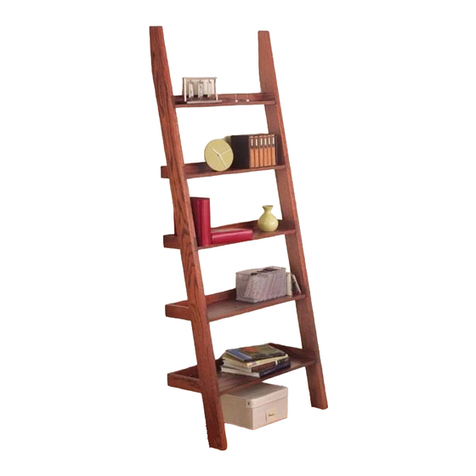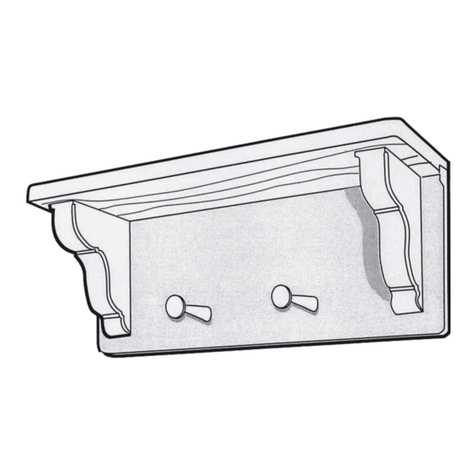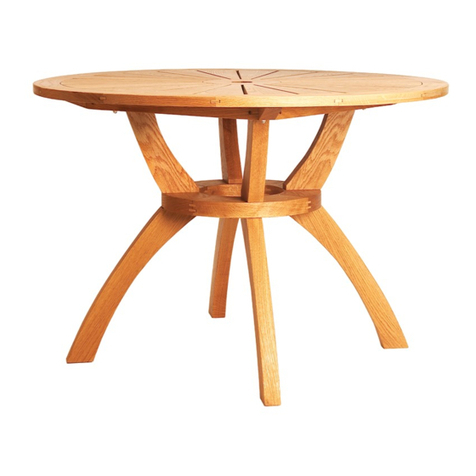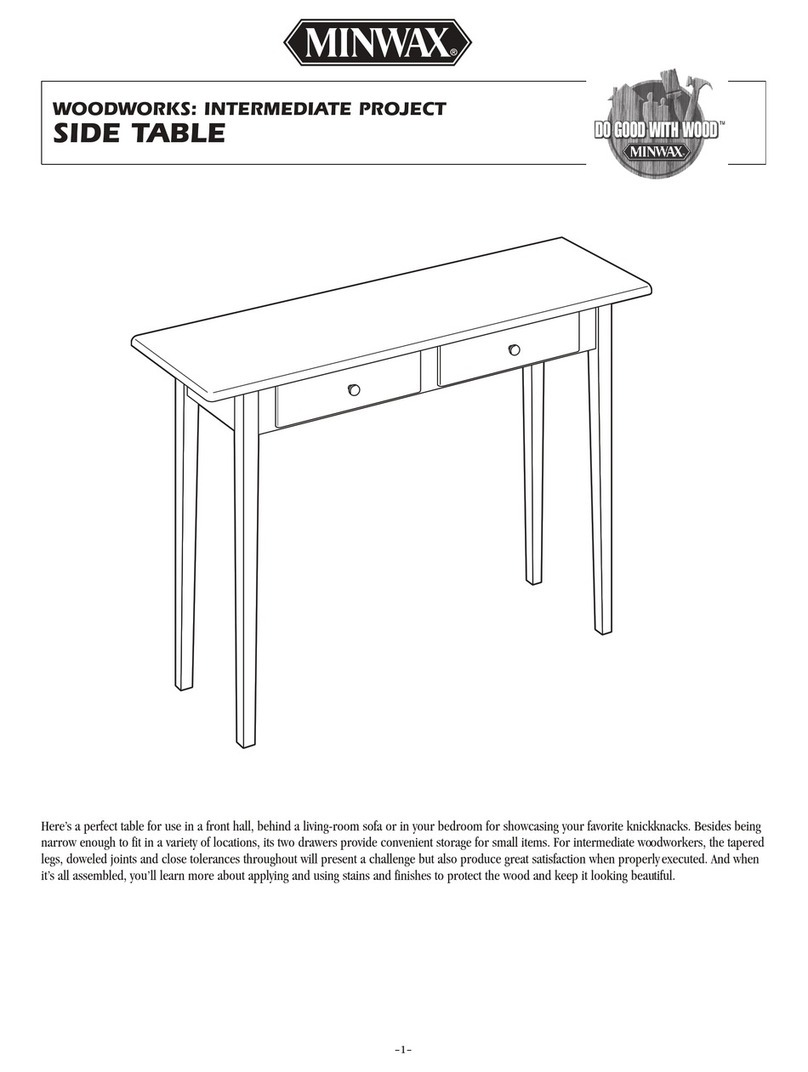46. The following day, sand all surfaces lightly with 220-grit sandpaper.
Dust off and wipe the piece with a cloth lightly dampened with mineral
spirits and apply the third and final coat of polyurethane.
Applying Clear Brushing Lacquer
47. Stir Minwax®Clear Brushing Lacquer well before and during
use to rotate the product from the bottom to the top of the can.
NEVER SHAKE.
48. Apply a coat of lacquer using a high-quality natural- or synthetic-
bristle brush. Apply sufficient lacquer to seal open joints, edges and
end grain.
49. Let the first coat dry at least 2 hours, then apply a second coat.
50. Apply a third coat, repeating the steps above for each coat. Apply a
fourth coat, if desired.
51. After the final coat, allow at least 24 hours before using.
Alternate Finish
52. Apply Minwax®Polyshades®following the directions on the can. Use
a good quality, natural-bristle brush suitable for use with polyurethane.
Stir the can contents thoroughly before starting and periodically repeat
stirring during your work session. Allow the first coat to dry overnight.
53. The next day, sand all surfaces lightly with 220-grit sandpaper or
very fine (000) steel wool using with-the-grain strokes. Dust off and
wipe all surfaces with a cloth dampened with mineral spirits. Apply a
second coat of Polyshades®and set the rack aside to cure overnight.
To achieve a deeper color, you may apply a third coat after 4-6 hours,
repeating the application directions. Allow the finish to cure for several
days before using the stand.
WWooooddwwoorrkkeerr’’ssTTiipp::If you achieve the desired color on the first
or second coats of Polyshades®, apply a clear coat of Minwax®
Fast-Drying Polyurethane or Minwax®Wipe-On Poly for added
protection.
54. When the staining and finishing is complete and the topcoat is
cured, install the doors, knobs and drawer.
PRODUCT SAFETY
For your safety and the safety of those you work with, always read the
safety warnings, which manufacturers print on their labels, and follow
them to the letter.
WARNING! Removal of old paint by sanding, scraping or other means
may generate dust or fumes that contain lead. Exposure to lead dust or
fumes may cause brain damage or other adverse health effects, espe-
cially in children or pregnant women. Controlling exposure to lead or
other hazardous substances requires the use of proper protective
equipment, such as properly fitted respirator (NIOSH approved) and
proper containment and cleanup. For more information, call the
National Lead Information Center at 1-800-424-LEAD (in U.S.) or
contact your local health authority.
DANGER: Rags, steel wool, other waste soaked with oil-based stains
and clear finishes, and sanding residue may spontaneously catch fire if
improperly discarded. Immediately place rags, steel wool, other waste
soaked with this product, and sanding residue in a sealed, water-filled
metal container. Dispose of in accordance with local fire regulations.
When using oil-based wood finishing products:
CAUTIONS: CONTAINS ALIPHATIC HYDROCARBONS.
Contents are COMBUSTIBLE. Keep away from heat and open flame.
VAPOR HARMFUL. Use only with adequate ventilation. To avoid over-
exposure, open windows and doors or use other means to ensure fresh
air entry during application and drying. If you experience eye watering,
headaches, or dizziness, increase fresh air, or wear respiratory protec-
tion (NIOSH approved), or leave the area. Avoid contact with eyes and
skin. Wash hands after using. Keep container closed when not in use.
Do not transfer contents to other containers for storage.
FIRST AID: In case of eye contact, flush thoroughly with large
amounts of water for 15 minutes and get medical attention. For skin
contact, wash thoroughly with soap and water. In case of respiratory
difficulty, provide fresh air and call physician. If swallowed, call Poison
Control Center, hospital emergency room, or physician immediately.
DELAYED EFFECTS FROM LONG-TERM OVEREXPOSURE.
Contains solvents which can cause permanent brain and nervous
system damage. Intentional misuse by deliberately concentrating
and inhaling contents may be harmful or fatal.
WARNING: This product contains a chemical known to the State of
California to cause cancer and birth defects or other reproductive
harm. DO NOT TAKE INTERNALLY. KEEP OUT OF REACH OF
CHILDREN. CONFORMS TO ASTM D-4326. Contact a physician for
more health information.
When using water-based wood finishing products:
CAUTIONS: Use Only With Adequate Ventilation. To avoid overexpo-
sure, open windows and doors or use other means to ensure fresh air
entry during application and drying. If you experience eye watering,
headaches, or dizziness, increase fresh air, or wear respiratory protec-
tion (NIOSH approved), or leave the area. Avoid contact with eyes and
skin. Wash hands after using. Keep container closed when not in use.
Do not transfer contents to other containers for storage.
FIRST AID: In case of eye contact, flush thoroughly with large
amounts of water. Get medical attention if irritation persists.
If swallowed, get medical attention immediately.
WARNING: This product contains a chemical known to the State of
California to cause cancer and birth defects or other reproductive harm.
DO NOT TAKE INTERNALLY. KEEP OUT OF REACH OF CHILDREN.
CONFORMS TO ASTM D-4326. Contact a physician for more health
information.
–5–
CONTINUED - WOODWORKS: ADVANCED PROJECT 2008-2009 TV STAND






























